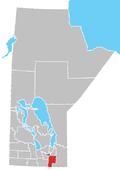Place in Manitoba, Canada
| Sainte Agathe | |
|---|---|
 Ste. Agathe Roman Catholic Church located along the Red River in Ste. Agathe, Manitoba. Ste. Agathe Roman Catholic Church located along the Red River in Ste. Agathe, Manitoba. | |
 | |
| Coordinates: 49°34′06″N 97°10′57″W / 49.56833°N 97.18250°W / 49.56833; -97.18250 | |
| Country | Canada |
| Province | Manitoba |
| Region | Eastman |
| Established | 1876 |
| Government | |
| • Mayor | Chris Ewen |
| • Councillor | Joel Lemoine |
| • Governing Body | Rural Municipality of Ritchot |
| • MLA (Springfield-Ritchot) | Ron Schuler |
| • MP (Provencher) | Ted Falk |
| Elevation | 238 m (781 ft) |
| Population | |
| • Total | 643 |
| Time zone | UTC-6 (CST) |
| • Summer (DST) | UTC-5 (CDT) |
| Postal Code | R0G 0C9, R0G 1Y0, R0G 1Y1 |
Ste. Agathe is a primarily francophone community in the Rural Municipality of Ritchot, Manitoba, Canada, located along the Red River.
Ste. Agathe is in the provincial riding of Morris and the federal riding of Provencher.
History
The village was founded in the mid-19th century on one of the Red River Trails by settlers from Quebec named Grouette, who built a homestead on the west bank of the Red River and farmed grain in the rich soil of the valley. A dock allowed other settlers to reach the east side of the river via ferry with their grain-laden Red River carts; a community, originally called Pointe-à-Grouette, formed around the docking point at some time before 1871.
The first mention of the name "Ste. Agathe" was some decades earlier, when the Roman Catholic Church organized the Red River colonies between St. Norbert and the United States border into the Parish of Sainte-Agathe. As that parish grew and split into numerous more manageable parishes, the parish containing Pointe-à-Grouette was renamed the Parish of Sainte-Agathe by Archbishop Alexandre-Antonin Taché in 1873; the town adopted the name at some time after that date. A church, a school, and eventually a convent were built at the townsite.
1997 flood
It is located in the floodplain of the Red River and, as such, has always been prone to flood damage, but none was so severe or as notable as that experienced during the 1997 Red River flood. The ring dike surrounding the town gave out in late April, causing the town to be inundated with over two metres of water. The village has recovered; a new dike has been built and an interpretive centre has been created on the west side of the community.
Demographics
In the 2021 Census of Population conducted by Statistics Canada, Ste. Agathe had a population of 643 living in 225 of its 226 total private dwellings, a change of 0.9% from its 2016 population of 637. With a land area of 4.01 km (1.55 sq mi), it had a population density of 160.3/km (415.3/sq mi) in 2021.
References
- "Ste. Agathe - Southwest Region - Destinations - Joie de Vivre". Archived from the original on April 23, 2019. Retrieved February 18, 2019.
- "Sainte Agathe, Steinbach, Canada on the Elevation Map. Topographic Map of Sainte Agathe, Steinbach, Canada".
- ^ "Population and dwelling counts: Canada and designated places". Statistics Canada. February 9, 2022. Retrieved September 3, 2022.
- "STE AGATHE, Manitoba Canada, Canada Postal Code Database, ZIP Code Database, ZIP Code Maps".
- ^ "Ste. Agathe booming since 'flood of the century'". CBC News. April 27, 2007. Retrieved January 9, 2017.
- "Census Profile, 2016 Census". Statistics Canada. January 23, 2017. Retrieved April 25, 2017.
- History of Ste. Agathe (in French) Archived 2001-04-22 at the Wayback Machine. Accessed August 12, 2008.
- Ste. Agathe falls victim to the flood. CBC News, broadcast April 29, 1997. Accessed August 12, 2008.
- Red River Valley Floods Interpretive Centre Archived 2009-11-19 at the Wayback Machine. Accessed August 12, 2008.
External links
| Division No. 2, Manitoba (Steinbach Area) | |||
|---|---|---|---|
| Cities |  | ||
| Towns | |||
| Villages | |||
| Rural municipalities |
| ||
| First Nations | |||
| Indian reserves | |||
| Unincorporated communities | |||